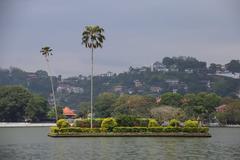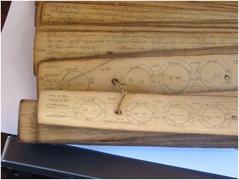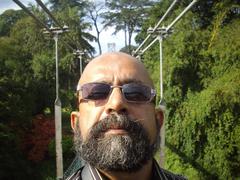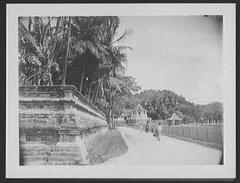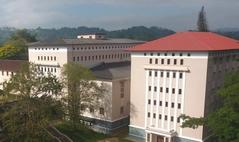Royal Palace of Kandy: Visiting Hours, Tickets, and Historical Sites in Kandy
Date: 15/06/2025
Introduction
The Royal Palace of Kandy, nestled in Sri Lanka’s cultural capital, stands as a remarkable testament to the island’s last indigenous monarchy and enduring heritage. Historically the seat of the Kandyan Kingdom, this architectural gem reflects centuries of Sinhalese sovereignty, artistic achievement, and religious significance. Adjacent to the revered Temple of the Tooth Relic—a UNESCO World Heritage Site—the palace complex is a living symbol of national pride and spiritual legacy.
This comprehensive guide offers in-depth insights into the Royal Palace’s history, key architectural features, visitor information, ticketing details, accessibility, travel tips, and nearby attractions. Whether you are a history enthusiast, cultural explorer, or spiritual pilgrim, this article will help you plan and enrich your experience in Kandy.
For the most up-to-date travel information, consult the Official Sri Lanka Tourism Website and the UNESCO listing for the Sacred City of Kandy.
Table of Contents
- Introduction
- Historical Overview and Cultural Significance
- Architectural Features and Layout
- Visitor Information: Hours, Tickets & Accessibility
- Travel Tips and Nearby Attractions
- Visuals and Media
- Frequently Asked Questions (FAQ)
- Conclusion
- Useful Links & References
Historical Overview and Cultural Significance
Origins and Evolution
The Royal Palace of Kandy was primarily built during the reign of King Vimaladharmasuriya I (1592–1604), who established Kandy as the capital of the Kandyan Kingdom. Subsequent rulers, including King Sri Wickrama Rajasinghe, expanded the complex, which served as the monarchy’s residence and the kingdom’s political and ceremonial heart. The palace architecture masterfully blends indigenous Sinhalese design with South Indian and later colonial influences, illustrating the island’s dynamic past (Wikipedia).
Architectural Features and Layout
The palace complex comprises several key structures:
- Magul Maduwa (Audience Hall): Built in 1784, this hall features ornate wooden pillars and served as the venue for royal ceremonies and important diplomatic events, most notably the signing of the Kandyan Convention in 1815.
- Queen’s Palace (Maha Wasala): The elegant quarters of the queen, characterized by intricate woodwork and private gardens.
- King’s Palace (Raja Wasala): The king’s residence, now part of the Kandy National Museum, showcasing royal regalia and artifacts.
- Ulpange (Queen’s Bathing Pavilion): A unique structure highlighting ritual purity and royal luxury.
- Temple of the Tooth Relic (Sri Dalada Maligawa): Adjacent to the palace, this sacred temple houses the Buddha’s tooth relic—a symbol of royal legitimacy and spiritual authority (TravelTriangle).
Beyond these, the palace grounds include lush gardens, lotus ponds, and stone pathways, creating a serene environment for visitors.
Political and Religious Significance
The palace was the center of Kandyan governance and diplomacy. Its proximity to the Temple of the Tooth Relic imbued it with deep religious importance; possession of the relic was considered essential for legitimate rule. The annual Esala Perahera festival, held in and around the palace and temple complex, is among Sri Lanka’s grandest processions, drawing thousands of visitors for its dazzling display of tradition and devotion (UNESCO).
Colonial Transformation and Preservation
Following British annexation in 1815, parts of the palace fell into disrepair or were repurposed. Today, the palace is protected as part of the UNESCO-listed Sacred City of Kandy, with ongoing efforts to preserve its architectural and historical integrity.
Visitor Information: Hours, Tickets & Accessibility
Visiting Hours
- Royal Palace of Kandy: Open daily from 8:00 AM to 4:00 PM (Holidify), with some areas open until 5:00 PM depending on the season and events.
- Temple of the Tooth Relic: Open daily from 5:30 AM to 8:00 PM, with ceremonial rituals occurring throughout the day.
Ticket Prices
- Foreign Adults: LKR 1,500
- Foreign Children (under 12): LKR 750
- Sri Lankan Residents: LKR 150–250
- Children (Sri Lankan Residents): Reduced rates or free
- Video Camera Fee: LKR 300 (where applicable)
- Tickets are available at the entrance or online via official tourism portals.
Facilities and Accessibility
- Restrooms: Available within the palace and nearby.
- Shaded Seating: Rest areas are found throughout the complex.
- Accessibility: Main pathways are generally accessible, but some historic sections have uneven terrain or steps. Visitors with limited mobility should contact the visitor center in advance for assistance.
- Photography: Allowed in most areas, but restricted inside the Temple of the Tooth Relic and specific museum galleries.
Guided Tours
Guided tours—both group and private—are offered on-site and through local agencies. Tours provide rich historical and cultural context, often including augmented or virtual reality features for an enhanced experience (Wonders of Ceylon).
Architectural Highlights
The Royal Palace of Kandy showcases traditional Kandyan architectural principles:
- Natural Integration: Structures are harmoniously integrated with the landscape, using timber, stone, and clay suited for the local climate (Trawell.in).
- Intricate Woodwork: The Magul Maduwa’s pillars and beams are adorned with floral and geometric carvings (SriLankaView).
- Stucco and Terra-Cotta: Interiors feature decorative motifs inspired by Buddhist mythology.
- Spacious Courtyards and Gardens: Tranquil outdoor spaces provide privacy and serenity (Secret Attractions).
Among the surviving structures open to visitors are the King’s Palace (Raja Wasala), Queen’s Palace (Meda Wasala), King’s Harem Quarters (now the National Museum), and the Ulpange bathing pavilion (Wikipedia).
Travel Tips and Nearby Attractions
Best Time to Visit
- Dry Season: December to April offers the most comfortable weather.
- Festivals: The Esala Perahera (July–August) is a spectacular time to visit but expect large crowds and higher prices (rofi.lk).
Dress Code & Etiquette
- Modest Dress: Shoulders and knees should be covered when entering religious sites.
- Shoes & Hats: Remove before entering the Temple of the Tooth or palace interiors.
- Silence & Respect: Maintain quiet during rituals and ceremonies.
Getting There
The palace is centrally located in Kandy, just 1.5 km from the railway station and main bus terminal. Tuk-tuks, taxis, and local buses provide easy access (kandycity.org).
Nearby Attractions
- Temple of the Tooth Relic: Iconic Buddhist site, daily rituals, and the Esala Perahera (UNESCO).
- Kandy Lake: Created in 1807, ideal for strolls and scenic views (Thrillophilia).
- Udawattakele Sanctuary: Forest reserve with nature trails and endemic wildlife (atickettotakeoff.com).
- Royal Botanic Gardens, Peradeniya: 6 km away, famous for its diverse plant species (Thrillophilia).
- Bahirawakanda Buddha Statue: Panoramic city views from this 88-foot hilltop Buddha (Thrillophilia).
- Kandy Central Market: Local crafts, fresh produce, and textiles (atickettotakeoff.com).
- Kadugannawa Tea Factory: Insight into Sri Lanka’s tea industry with guided tours and tastings (Thrillophilia).
Recommended Itinerary
- Morning: Explore the Royal Palace and Museum.
- Midday: Visit the Temple of the Tooth.
- Afternoon: Walk around Kandy Lake or relax in the Royal Botanic Gardens.
- Evening: Enjoy a cultural performance or shop at the Central Market.
Visuals and Media
- High-resolution images with alt tags such as “Royal Palace of Kandy entrance,” “Magul Maduwa audience hall,” and “Palace gardens Kandy historical sites.”
- Interactive map highlighting the palace’s location and nearby attractions.
- Virtual tour/video walkthrough (search for available content online).
Frequently Asked Questions (FAQ)
Q: What are the Royal Palace of Kandy visiting hours?
A: Open daily from 8:00 AM to 4:00 PM; some areas until 5:00 PM.
Q: How much are tickets?
A: Foreign adults: LKR 1,500; foreign children: LKR 750; Sri Lankan residents: LKR 150–250.
Q: Are guided tours available?
A: Yes, both group and private tours are offered on-site and by local agencies.
Q: Is the palace accessible for visitors with disabilities?
A: Many main pathways are accessible, but some historic sections have steps or uneven surfaces.
Q: Can I take photographs inside the palace?
A: Yes, except in the Temple of the Tooth Relic interior and some museum sections.
Quick Reference Table: Key Attractions Near the Royal Palace
| Attraction | Distance from Palace | Highlights |
|---|---|---|
| Temple of the Tooth Relic | Adjacent | Sacred relic, daily rituals, Esala Perahera |
| Kandy Lake | 0.1 km | Scenic walks, historical island |
| Udawattakele Sanctuary | 0.5 km | Forest trails, wildlife |
| Royal Botanic Gardens, Peradeniya | 6 km | 4,000+ plant species, picnic spots |
| Bahirawakanda Buddha Statue | 2 km | Panoramic city views |
| Kandy Central Market | 0.7 km | Local produce, crafts, textiles |
| Kadugannawa Tea Factory | 15 km | Tea tours, tastings, scenic vistas |
Conclusion
The Royal Palace of Kandy offers an unparalleled glimpse into Sri Lanka’s royal past and cultural richness. Its blend of architectural beauty, historical gravitas, and vibrant religious traditions makes it a must-visit for any traveler to Kandy. With accessible visiting hours, reasonable ticketing, and a wide array of nearby attractions, the palace complex caters to diverse interests and ensures a memorable visit.
Plan ahead for the best experience: respect local customs, dress appropriately, and consider joining a guided tour to deepen your understanding of the site’s significance. For ongoing updates, downloadable travel guides, and exclusive content, download the Audiala app and follow our channels.
Useful Links & References
- Official Sri Lanka Tourism Website
- Kandy National Museum
- Sacred City of Kandy - UNESCO
- Royal Palace Complex of Kandy - Wikipedia
- Royal Palace of Kandy - TravelTriangle
- Things to Do in Kandy - Atickettotakeoff
- Kandy Cultural Festivals - Rofi.lk
- Best Hiking Trails near Kandy - Atickettotakeoff
For further reading and the latest updates, consult the references above and explore our related articles on Kandy’s historical sites, festivals, and travel itineraries.
